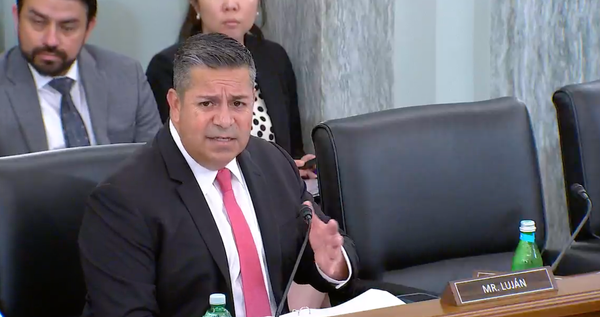NTIA OKs Virginia’s Broadband Plan, Commonwealth Launches BEAD Challenge Process
It is the second state to start ground-truthing broadband data as part of the $42.5 billion program under IIJA.

WASHINGTON, November 1, 2023 – Virginia on Wednesday became the second state in the nation to begin its Broadband Equity, Access and Deployment program challenge process, kicking off the process one week after approval of its plan by the U.S. Commerce Department.
The move marks the next step forward in the $42.5 billion federal effort to expand broadband access. Many states are still in the process of submitting initial proposals for administering their grant programs, ahead of the December 27 deadline.
“Our goal is to ensure that every unserved and underserved home, business, and community anchor institution is included in the BEAD program,“ said Dr. Tamarah Holmes, director of the Office of Broadband within Virginia’s Department of Housing and Community Development.
“We eagerly anticipate collaborating with local governments, non-profits, and community anchor institutions during the 30-day challenge window and the subsequent review process to address all broadband access gaps,” she said.
Virginia continues the momentum of other leading state broadband offices, including Louisiana, the first state to begin its challenge process under BEAD on October 6.
Virginia’s challenge process is being carried out through partnership with Virginia Tech Center for Geospatial Information Technology to provide the challenge process portal, and Ready, which is supporting Virginia’s challenge effort with its public map and speed test portal. Ready also offers a Challenge Process Coordinator as part of a software platform to assist leading state broadband offices in being data-driven, scalable and compliant throughout their broadband programs.
A requirement to accept challenges
BEAD rules under the November 2021 Infrastructure Investment and Jobs Act require states to accept and process challenges to broadband availability data before awarding grants under the program. The Federal Communications Commission coverage map that states will use as a starting point is based largely on provider-reported data, which is not considered accurate enough to determine which locations – that is, individual businesses and housing units – have adequate internet access.
The program prioritizes areas marked as “unserved” – those with access to speeds of 25 megabits per second download speed and 3 Mbps upload speed– for subsidized infrastructure projects, followed by ‘underserved’ areas – those with less than 100 * 20 Mbps.
Virginia has identified 134,221 unserved and 27,806 underserved locations eligible to get broadband with BEAD-funded infrastructure, based on data from the FCC National Broadband Map and previous federal and state funding programs. It will use those numbers as a baseline as it begins processing challenges.
Virginia has in fact identified more than 400,000 locations that are unserved and underserved, but which are already including a state- or federally-funded project area. Such areas are ineligible for funding and are hence removed from the 162,107 “pre-challenge” locations at issue in Virginia’s process.
Adopting NTIA’s model challenge process
Virginia adopted the NTIA’s model challenge process, a template the agency put together for states to expedite the proposal approval process. The process is slated to last 90 days, ending in Virginia on January 30, 2024. The state will be accepting challenges for the first 30 days, until November 30, followed by rebuttal and adjudication phases of the same length.
Challenges in the state can allege that current data on things like the internet speed, technology type, latency, and data caps available at a location is inaccurate. They can only be submitted by nonprofits, municipal governments, and internet service providers, meaning eligible challengers must source evidence of these inaccuracies from their communities or, in the case of providers, internal plans and network management systems.
That evidence can broadly come in the form of provider documents or communications with information on service and equipment or, in the case of latency, speed tests showing an excessive delay in network communications.
Virginia is making use of two optional modifications the NTIA laid out: area challenges and MDU, or multiple dwelling unit, challenges. Under these rules, if six locations in a census block group or 10 percent of the units in an apartment building challenge the same provider’s technology or coverage, the provider must provide evidence that they serve the entire block group or building as reported in government data.
Requirement of enforceable commitments for broadband
The state is also more stringent than the NTIA model on providers claiming to have plans in place to serve BEAD-eligible areas. If a provider submits a challenge to Virginia claiming they are – independent of BEAD – planning to get broadband to certain unserved homes and businesses, the state will require them to enter into an enforceable commitment before marking those locations as served.
Most states are adopting the NTIA’s model process in full, with almost every state basing their process heavily in it. Some states are accepting other forms of evidence, like speed tests measuring network capacity, and making other optional modifications, like marking service from certain technologies as underserved by default.
Providers in Virginia will have 30 days from the notification of a challenge to rebut challenges. The state will then weigh evidence and make determinations on its final broadband map by January 30.
Virginia has already submitted the second volume of its initial proposal, detailing how it plans to award BEAD grants based on that map, to the NTIA. It is one of only two states to have done so, with the other being Louisiana. Virginia will have one year from the approval of that proposal to spend all $1.7 billion of its allocation.










